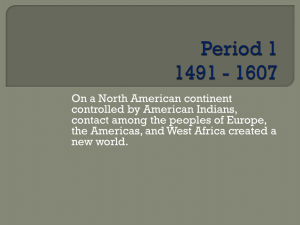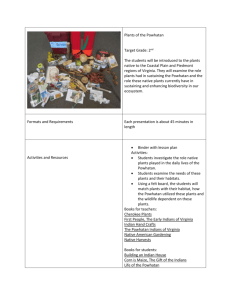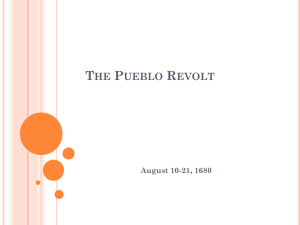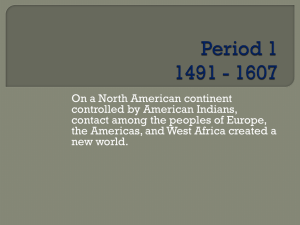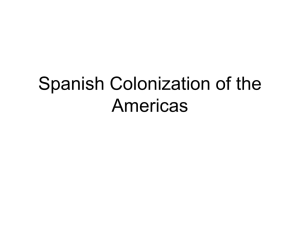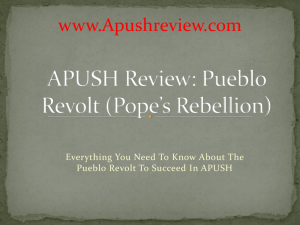American Indian Affairs
advertisement
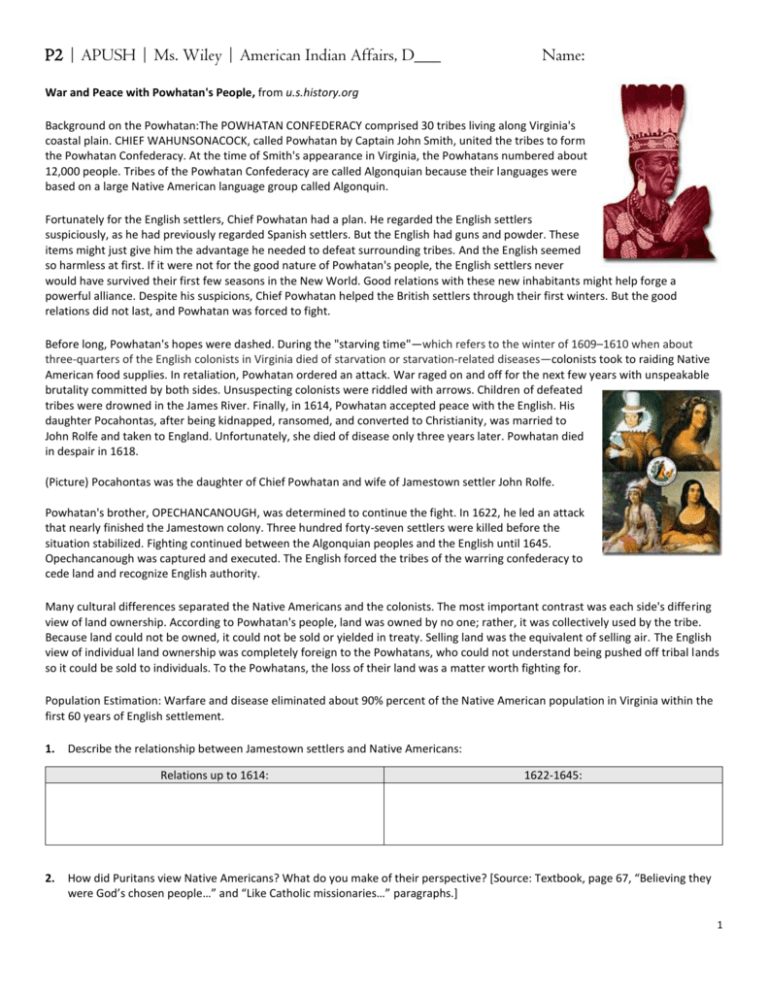
P2 | APUSH | Ms. Wiley | American Indian Affairs, D___ Name: War and Peace with Powhatan's People, from u.s.history.org Background on the Powhatan:The POWHATAN CONFEDERACY comprised 30 tribes living along Virginia's coastal plain. CHIEF WAHUNSONACOCK, called Powhatan by Captain John Smith, united the tribes to form the Powhatan Confederacy. At the time of Smith's appearance in Virginia, the Powhatans numbered about 12,000 people. Tribes of the Powhatan Confederacy are called Algonquian because their languages were based on a large Native American language group called Algonquin. Fortunately for the English settlers, Chief Powhatan had a plan. He regarded the English settlers suspiciously, as he had previously regarded Spanish settlers. But the English had guns and powder. These items might just give him the advantage he needed to defeat surrounding tribes. And the English seemed so harmless at first. If it were not for the good nature of Powhatan's people, the English settlers never would have survived their first few seasons in the New World. Good relations with these new inhabitants might help forge a powerful alliance. Despite his suspicions, Chief Powhatan helped the British settlers through their first winters. But the good relations did not last, and Powhatan was forced to fight. Before long, Powhatan's hopes were dashed. During the "starving time"—which refers to the winter of 1609–1610 when about three-quarters of the English colonists in Virginia died of starvation or starvation-related diseases—colonists took to raiding Native American food supplies. In retaliation, Powhatan ordered an attack. War raged on and off for the next few years with unspeakable brutality committed by both sides. Unsuspecting colonists were riddled with arrows. Children of defeated tribes were drowned in the James River. Finally, in 1614, Powhatan accepted peace with the English. His daughter Pocahontas, after being kidnapped, ransomed, and converted to Christianity, was married to John Rolfe and taken to England. Unfortunately, she died of disease only three years later. Powhatan died in despair in 1618. (Picture) Pocahontas was the daughter of Chief Powhatan and wife of Jamestown settler John Rolfe. Powhatan's brother, OPECHANCANOUGH, was determined to continue the fight. In 1622, he led an attack that nearly finished the Jamestown colony. Three hundred forty-seven settlers were killed before the situation stabilized. Fighting continued between the Algonquian peoples and the English until 1645. Opechancanough was captured and executed. The English forced the tribes of the warring confederacy to cede land and recognize English authority. Many cultural differences separated the Native Americans and the colonists. The most important contrast was each side's differing view of land ownership. According to Powhatan's people, land was owned by no one; rather, it was collectively used by the tribe. Because land could not be owned, it could not be sold or yielded in treaty. Selling land was the equivalent of selling air. The English view of individual land ownership was completely foreign to the Powhatans, who could not understand being pushed off tribal lands so it could be sold to individuals. To the Powhatans, the loss of their land was a matter worth fighting for. Population Estimation: Warfare and disease eliminated about 90% percent of the Native American population in Virginia within the first 60 years of English settlement. 1. Describe the relationship between Jamestown settlers and Native Americans: Relations up to 1614: 2. 1622-1645: How did Puritans view Native Americans? What do you make of their perspective? [Source: Textbook, page 67, “Believing they were God’s chosen people…” and “Like Catholic missionaries…” paragraphs.] 1 Metacom’s War or King Philip’s War (1675-1678), from Digital History Throughout the 17th century the indigenous people of New England declined rapidly in numbers and suffered severe losses of land and cultural independence. While the indigenous population fell from 140,000 to 10,000, the English population grew to 50,000. Meanwhile, the New England Puritans launched a concerted campaign to convert the Indians to Protestantism. John Eliot, New England's leading missionary, convinced about 2000 to live in "praying towns," where they were expected to adopt white customs. New England Indians were also forced to accept the legal authority of colonial courts. Faced with death, disease, and cultural disintegration, many of New England's native peoples decided to strike back. In 1675, the chief of the Pokanokets, Metacome (whom the English called King Philip), forged a military alliance including about two-thirds of the region's Indians. In 1675, he led an attack on Swansea, Massachusetts. Over the next year, both sides raided villages and killed hundreds of victims. Twelve out of ninety New England towns were destroyed. The last major Indian war in New England, King Philip's War was the most destructive conflict, relative to the size of the population, in American history. Five percent of New England's population was killed--a higher proportion than Germany, Britain, or the United States lost during World War II. Indian casualties were far higher; perhaps 40 percent of New England's Indian population was killed or fled the region. When the war was over, the power of New England's Indians was broken. The region's remaining Indians would live in small, scattered communities, serving as the colonists' servants, slaves, and tenants. England dispatched Edward Randolph (1632-1703) to determine the conflict's causes and assess the damage. Randolph argued that the government of Puritan Massachusetts viewed the Indian attacks as punishment for their own sins. This idea of divine punishment derives from the Old Testament, which continually interprets attacks on the ancient Israelites as punishment for sin. This provided a model for the Puritans and their descendants down to Abraham Lincoln's Second Inaugural Address, which pictured the Civil War as God's punishment on the American people for the sin of slaveholding. But Randolph also highlighted other inconvenient reasons: ”the English have contributed much to their misfortunes, for they first taught the Indians the use of arms, and admitted them to be present at all their musters and trainings, and showed them how to handle, mend and fix their muskets, and have been furnished with all sorts of arms by permission of the government...” 3. Why did New England’s native peoples decide to “strike back”? 4. How did Metacom (nicknamed by the English as King Philip) organize the war? 5. What were the results of the war? 6. How did Edward Randolph, a colonial administrator, explain the war and its causes? The Pueblo Revolt, by Edward Countryman, from Gilder Lehrman In 1680 the people known collectively as “Pueblos” rebelled against their Spanish overlords in the American Southwest. Spaniards had dominated them, their lives, their land, and their souls for eight decades. The Spanish had established and maintained their rule with terror, beginning with Juan de Oñate’s invasion in 1598. When the people of Acoma resisted, Oñate ordered that one leg be chopped from every man over fifteen and the rest of the population be enslaved, setting a pattern that lasted four-score years. Now, rising virtually as one, the Pueblos drove out Spanish soldiers and authorities. The rebels allowed many Spaniards to flee, but twenty-one Franciscan priests died at their hands, and they sacked mission churches across their land. It took twelve years for 2 Spanish troops to reconquer Pueblo country. They never did conquer the Hopi, who had been the westernmost contributors to the rebellion. Three hundred and thirty years later, Pueblo people still live in ancient villages across the Southwest, in many ways on their own terms. A proud statue of the rebellion’s leader, Popé (or Po’pay), is one of New Mexico’s two pieces in the National Statuary Hall in the United States Capitol. The Pueblo Revolt was the greatest and most successful rebellion of its sort in North American history. What happened? What did it signify? What did it achieve? Unquestionably, one of the revolt’s dimensions was religious. Pueblo people had had enough of Christianity, after eight decades of living in what historian Ramón Gutiérrez has described as an imposed theocratic utopia. Backed by armed force and not reluctant to use the whip, Catholic missionaries had set out to destroy the ancestral Pueblo world in every respect, including what people could believe and how they could marry, work, live their lives, and pray. When the rebels could capture Franciscan priests, they killed them, sometimes after torturing them. They destroyed Catholic images, tore down mission churches, and defiled the vessels of the Catholic Mass. They put an end to marriages on Christian terms. They restored the kivas where Pueblo men had honored their ancestral Kachinas. With Catholic symbols and Spanish practices gone, the Pueblos set out to restore the lives their ancestors had lived. Po’pay’s great achievement was to coordinate the Pueblos. There was no distinct “Pueblo” people, speaking one language and sharing one culture. Instead, the Spanish conquerors had found Keres, Tompiros, Tewas, Tiwas, Towas, Piros, and Zuni, all living in similar-looking adobe villages (pueblos, hence the name), as well as Utes, Navajos, and Apaches. Their languages differed greatly, and their relations with one another were not always friendly. Nonetheless, Po’pay’s plan worked nearly perfectly. The Spanish rulers in Santa Fe received only the barest warning before the revolt broke out. People in their settled adobe villages had had centuries to build relationships and customs, of commerce, alliance, peace, and war. If a conflict led to war, village people knew how to abandon their permanent sites and find refuge among wanderers. If anything, the Spanish invasion intensified Native connections with one another. They learned about horses, mules, burros, cattle, sheep, and Spanish tools and weapons. The 1680 uprising was no isolated event. The seventeenth-century history of modern New Mexico and northern Mexico is punctuated by unrest and rebellion. Many of the region’s people had been conquered and none liked their situation, but they understood that though they greatly outnumbered the Spaniards, their foes were ruthless, organized, and determined. The Spanish possessed firearms and steel weapons superior to anything the Natives could muster. But despite all the odds against successful resistance, Spanish records show instance upon instance of plans and outbreaks among American Indians who supposedly had been “reduced” to Christianity and Spanish ways. Slavery, rather than symbolic religious conflict, may have provided the deep underpinning of the southwestern events. Legal enslavement of American Indians by Spaniards had been forbidden by royal decree since the mid-sixteenth century, but that did not stop the actual practice. So-called “just wars” provided one loophole, and on that basis Apaches, Utes, and others who refused to acknowledge Spanish authority were fair game for enslavers. Settled Christian Indians, such as the Pueblos, could be enslaved for a period of time, if they resisted their condition. Forced encomienda labor, supposedly rendered in return for the benefits the Spaniards had brought, was not far from actual slavery. Enslaved Indians often ended up in the booming, labor-hungry silver mines of Chihuahua, but some were taken farther south and a few as far as Cuba, to work side by side with captured Africans. A lively traffic flourished across the plains in Native women and children, for both sexual exploitation and domestic labor. Outside the Spanish zone, slaving frontiers were pushing westward onto the plains both from New France and from the British colonies, particularly newly founded South Carolina. Pueblo, Apache, and Navajo country lay many miles from the European centers, but its people were caught up in an enormous web whose most-shared institution was human bondage. The Spanish return in 1692 was a military conquest, just as 1598 had been, but it did not lead to a full restoration of their authority, due in part to the Spanish themselves. Secular Spanish officials began trying to rule “their” Indians in enlightened terms. They saw New Mexico not as mission country, where the friars had to be protected as they went about their task of saving Native souls, but rather as a buffer zone, protecting the precious silver mines from the not-so-distant French and even the British. They saw the New Mexican people as possible allies in the game of transcontinental empire, to be courted rather than conquered. The self-sacrificing, martyrdom-seeking zealotry of seventeenth-century Franciscan “Conquistadors of the Spirit” slackened into routine business. 3 If the purpose of the rebellion was simply to drive out Spanish ways, it failed, because the Spaniards came back and remained until Mexican independence in 1821. The Spanish were followed by two successor republics, Mexico and, ultimately, the United States. There could be no complete return to how Pueblo people had lived prior to the Spanish conquest. But if the rebels’ purpose was to reassert their own ways in a new setting, their rebellion succeeded. 7. How would you describe Spanish-Pueblo relations prior to 1680? 8. What happened during the Pueblo Revolt? Provide a general overview: 9. What were the religious dimensions to this conflict? 10. Who were the Pueblo people? 11. When the Spanish returned in 1692, how did things change? 4
